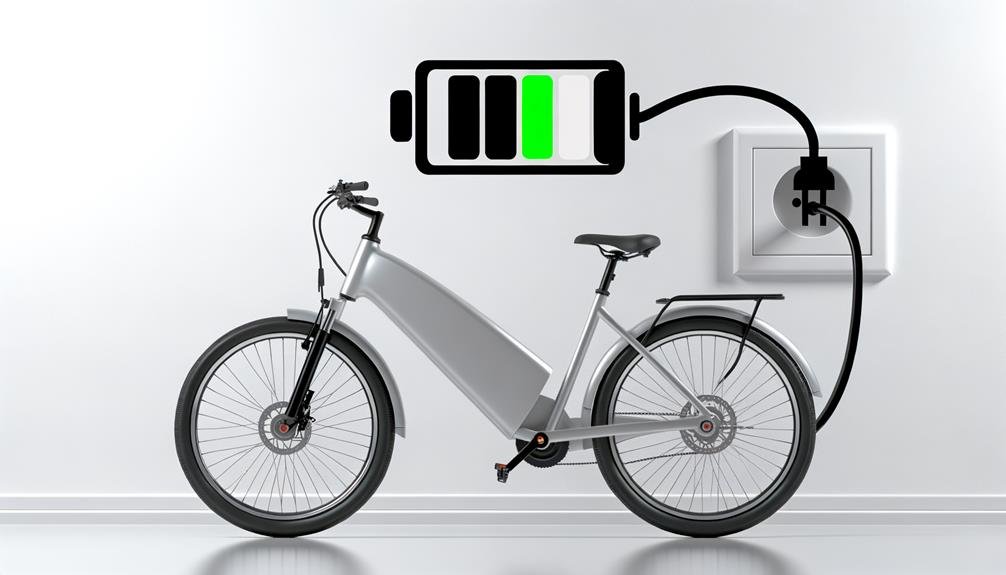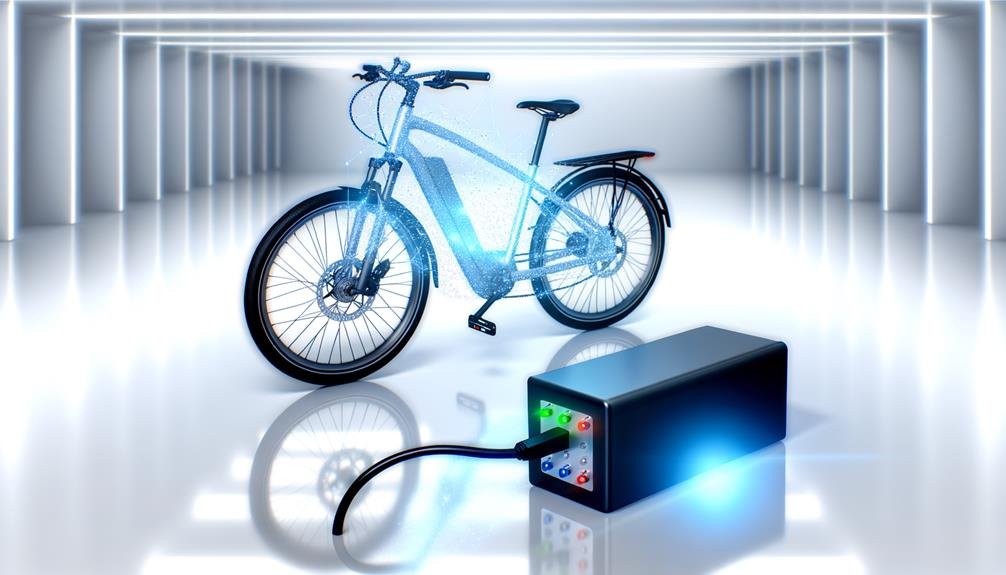Charles Miller is a veteran bike enthusiast with over 12 years of experience dealing with bikes as a mechanic. Despite immense love and expertise for...
In considering the longevity and efficiency of electric bikes, an important factor that arises is the charge retention of their batteries, particularly when the bikes are not in use and stored.
The duration for which an electric bike remains charged under storage conditions is influenced by multiple variables such as the type of battery, its age, the climate, and the specific storage conditions.
These factors interplay to determine the rate of self-discharge, a phenomenon that causes batteries to lose charge over time when not in use.
Consequently, understanding these factors can contribute significantly to maintaining the performance and lifespan of your electric bike's battery.
This discussion, therefore, aims to explore these nuances, shedding light on the intricacies of e-bike battery storage and management.
- Key Takeaways
- Understanding E-Bike Battery Life
- Types of Electric Bike Batteries
- Charge Cycles: A Key Factor
- Optimal Storage Conditions
- Impact of Temperature on Charge
- Tips for Prolonging Battery Life
- When to Replace Your Battery
- The Role of Battery Management Systems
- Exploring Lithium-ion E-Bike Batteries
- Battery Care During Winter Storage
- Frequently Asked Questions
- Conclusion
Key Takeaways
- The type of battery, age, climate conditions, and storage conditions all affect the charge retention and lifespan of electric bike batteries.
- Maximizing the lifespan and efficiency of electric bike batteries involves charging them to full capacity before storing, discharging them to about half capacity, and storing them at room temperature away from extreme temperatures and direct sunlight.
- Different types of electric bike batteries have varying characteristics, with lithium-ion batteries having superior energy density and long lifespan, lead acid batteries being heavier with a lower charge-cycle threshold, and nickel batteries having intermediate characteristics.
- Charge cycles gradually deteriorate battery capacity, so it's important to recharge the battery when it reaches 30-60% range, avoid complete discharge or overcharging, and regularly monitor the battery's charge level. Optimal storage conditions and regular battery maintenance also play a crucial role in preserving the vitality of the battery.
Understanding E-Bike Battery Life
In order to maximize the lifespan and efficiency of an electric bike's battery, it's imperative to understand certain key principles related to its charging, storage, and maintenance.
The first principle is to charge your battery to full capacity before storing. Then, discharge it to about half capacity to maintain optimal battery health. This approach ensures a balanced state of charge which is beneficial for the e-bike battery.
The environment in which you store your ebike is also crucial. The battery should be stored at room temperature and away from direct sunlight or extreme temperatures, which can cause damage. For extended storage periods, maintain a charge/discharge level of approximately 60% and perform periodic storage tests to assess any battery loss.
The standard e-bike battery is typically a Lithium-ion, favored for its durability. It can survive over 1000 charge cycles if stored at temperatures between 40 to 70F (5 to 20C).
Lastly, it is essential to regularly monitor the battery's charge level and use the appropriate charger. This careful handling can prevent degradation and significantly extend the battery life of your e-bike.
Types of Electric Bike Batteries
In the realm of electric bikes, various types of batteries are employed, each with its own unique set of characteristics. The most common types include Lithium-Ion and Lead Acid batteries.
These batteries differentiate in aspects such as charge cycles, power, self-discharge rate, weight, and durability, all of which influence the overall battery life of an e-bike.
Lithium-Ion Bike Batteries
What makes lithium-ion batteries the most prevalent type in e-bikes, you may wonder? The secret lies in their superior energy density and long life span. Lithium-ion bike batteries can withstand over 1000 charge cycles, making them a reliable choice for those who frequently use and store an e-bike.
But remember, the longevity of electric bike batteries depends on proper care. Storing the battery in a location with moderate temperature is key, as extremes can hasten degradation.
Here's a comparative glance at popular e-bike batteries:
| Battery Type | Life Span (Charge Cycles) |
|---|---|
| Lithium-ion | Over 1000 |
| Nickel | About 500 |
| Lead | Up to 300 |
Choose wisely, considering the manufacturer's reputation and warranty, to ensure lasting performance.
Lead Acid Batteries
While lithium-ion batteries dominate the e-bike market, another type worth noting is the lead acid battery, offering a different set of characteristics and performance metrics. These lead acid batteries, despite being heavier and having a lower charge-cycle threshold, can still be a viable option for some e-bike users.
- Weight: Lead acid batteries are significantly heavier than their lithium-ion counterparts, which can impact the bike's maneuverability and speed.
- Charge-Cycle Threshold: These batteries reach their limit at around 300 charges, less than half of the average lithium-ion battery life.
- Storage: To maintain the long-term lifespan of lead acid batteries, it is critical to store the battery in a cool, dry place.
Charge Cycles: A Key Factor

Understanding the concept of charge cycles, particularly how each cycle from 100% to 0% gradually deteriorates the battery, is integral to maximizing the lifespan of your electric bike's battery. Each charge cycle is an inevitable process that slowly degrades the battery's capacity. This is why it's essential to maintain an appropriate charge level, especially when the bike is stored for a long time.
It's recommended to recharge the battery when it reaches the 30-60% range, rather than allowing it to completely discharge or overcharge. This preventive measure can significantly extend the lifespan of your electric bike's battery.
Not using the battery for extended periods can lead to self-discharging, causing irreversible damage. To avoid this, the ideal charge status for lengthy storage is approximately 30 to 60%. This range ensures the battery remains healthy while stored.
The type of battery also plays a crucial role. Lithium-ion batteries, widely used in e-bikes, can survive over 1000 charge cycles. In contrast, nickel batteries can withstand about 500 charge cycles.
Optimal Storage Conditions
Preservation of your electric bike's battery life necessitates adherence to optimal storage conditions, which entail maintaining appropriate charge levels, avoiding extreme temperatures, and choosing suitable storage locations. The way you store your e-bike battery significantly impacts its performance and longevity.
To ensure the optimal storage conditions, consider these three key points:
- Charge Levels – Before storing, charge your battery to full capacity. Then gently discharge it to about half capacity. This prevents overdischarging during storage, which can degrade the battery.
- Temperature Control – Extreme temperatures can harm your battery. Always remove the battery from the bike for storage and ensure its environment maintains room temperature. Avoid excessive heat or direct sunlight.
- Storage Location – Dry locations are best for battery storage. Particularly in winter, ensure your battery is situated in a dry, room temperature setting.
Conducting a storage test before deciding on a location can help assess the potential for battery loss.
Impact of Temperature on Charge

Temperature plays a critical role in maintaining the health of your electric bike's battery, particularly during the charging process. Extreme temperature variations can significantly impact battery care, specifically how you store and charge your e-bike's battery.
Extreme temperatures, especially below 15°F (-10°C) and above 120°F (50°C), can inflict serious damage on e-bike batteries during storage. The ideal storage environment for e-bike batteries is a place where the temperature stays between 40 to 60°F (5 to 20°C) and the battery maintains a 40 to 50% charge.
The impact of temperature on charge becomes even more evident when dealing with a cold battery. Charging a cold battery should be avoided as it may cause cell damage. Instead, it is preferable to bring the battery to room temp before initiating the charging process.
For long-term storage, it's beneficial to check the battery charge level every 3-4 months. Storing the battery at a 100% charge is discouraged as it tends to degrade cells more quickly. Manufacturers often advise completing a charge and discharge cycle every 3 months to recalibrate the estimated range of the battery, contributing to an extended battery lifespan.
Tips for Prolonging Battery Life
In the pursuit of extending the longevity of an electric bike's battery, several factors need to be meticulously considered.
Essential measures such as optimal storage conditions, regular battery maintenance, and proper charging practices play a significant role in preserving battery health.
It is imperative to elucidate these specifics to ensure the maximum potential of the battery, thereby enhancing overall electric bike performance.
Optimal Storage Conditions
To maximize the longevity of your electric bike's battery, understanding and implementing optimal storage conditions is of paramount importance. Here are three key tips for Storing Your Electric bike:
- Temperature Control: Avoid extreme temperatures and store your ebike at room temperature. Batteries perform best at 20-25°C. Cold can reduce battery capacity, while heat can cause damage.
- Dry Environment: Keep your ebike away from moisture. Water can lead to corrosion of the battery contacts, impairing performance.
- Avoid Direct Sunlight: Prolonged exposure to direct sunlight can cause the battery to overheat, reducing its lifespan.
Regular Battery Maintenance
Preserving the vitality of your electric bike's battery necessitates regular and meticulous maintenance, with a key focus on charging habits and storage conditions.
Bike owners should aim to charge the battery to full capacity before storing for a lengthy period of time. This helps maintain its health and prolong its lifespan. However, it's important to gently discharge the battery to about half its capacity afterwards to prevent overdischarge.
Overcharging and overdischarging can be detrimental, hence, the ideal charge status for lengthy storage is approximately 30 to 60%.
Regular battery maintenance also includes storing the battery at room temperature to avoid extreme temperature damage.
Proper Charging Practices
Mastering the art of proper charging practices can significantly enhance your electric bike battery's lifespan and overall performance. To understand how long electric bikes stay charged when stored, it's vital to adopt good charging habits.
- Always charge your battery to full capacity before storing. This practice helps to prevent any potential damage from prolonged storage.
- Discharge your battery gently to about half its capacity before storing. This habit creates optimal storage conditions, maximizing the time your electric bike stays charged.
- Store the battery at room temperature. Extreme temperatures can cause damage, affecting how long your electric bike can hold its charge.
When to Replace Your Battery
In the realm of electric bike maintenance, recognizing the signs of a deteriorating battery is crucial, as it typically requires replacement after about two years of use when performance begins to decline. It's essential to understand when to replace your battery, as riding with a worn-out one can diminish the e-bike's performance.
Signs such as lack of power, voltage fluctuations, and the need for frequent recharging can indicate a dwindling battery's capacity. If you store your bike for long periods without using it, it's advisable to remove the battery and store it in a cool, dry place.
Here's a table summarizing key points to keep in mind:
| Signs | Prevention | Solution |
|---|---|---|
| Declining Performance | Use optimized charger | Replace Battery |
| Voltage Fluctuation | Avoid charging overheated battery | Replace Battery |
| Frequent Recharging | Recharge when halfway used | Replace Battery |
| Long periods without using | Store battery separately | Replace Battery |
| After 2 years of use | Not Applicable | Replace Battery |
The Role of Battery Management Systems

Battery Management Systems (BMS) play an essential role in optimizing the lifespan and performance of electric bike batteries.
By monitoring and controlling the charging and discharging processes, these systems ensure appropriate storage charge levels and prevent battery degradation due to overcharging or discharging.
Moreover, they regulate battery temperature during charging and storage, provide insights into battery health, and maintain optimal charge levels during extended storage periods.
Understanding Battery Management Systems
A vital element in the optimization and safeguarding of lithium-ion batteries utilized in electric bikes is the Battery Management System (BMS), which regulates the charging and discharging processes to enhance performance and prolong battery life.
- BMS prevents overcharging and over-discharging, thereby preserving your stored batteries' charge level and preventing potential damage.
- It monitors individual cells within the battery pack, ensuring balanced charging and discharging, thereby maintaining overall battery health.
- BMS provides crucial data about the battery's state of charge, state of health, and overall performance, which aids in efficient battery usage and maintenance.
In essence, battery management systems play a critical role in maximizing the lifespan and safety of lithium-ion batteries, making them indispensable in electric bike battery management.
Impact on E-bike Lifespan
Proper management of e-bike batteries significantly influences the lifespan and performance of electric bikes. This can be achieved through the use of Battery Management Systems. The health of the bike's batteries is maintained when storage conditions are appropriate. Ideally, the batteries should be stored within a temperature range of -10°C to 60°C.
Another important factor in preserving the battery's life is to avoid overcharging. Li-ion chargers typically have an automatic shut-off feature to prevent overcharging. This feature helps extend the lifespan of the battery.
In addition, it is equally important to avoid completely discharging the batteries. Doing so can cause irreversible damage to the battery. To prevent this, it is recommended to recharge the battery before it is completely drained.
The type of battery used in electric bikes also plays a role in its lifespan. Lithium-ion batteries are the most common type used in electric bikes. These batteries can survive over 1000 charge cycles, which significantly enhances the electric bike's lifespan.
Exploring Lithium-ion E-Bike Batteries
To ensure optimal performance and longevity of lithium-ion e-bike batteries, it is imperative to store them at room temperature and avoid exposure to extreme temperatures. When exploring lithium-ion e-bike batteries, there are numerous factors that can affect how long electric bikes stay charged if stored.
Here are three key considerations:
- Charge and Discharge Cycle: Lithium-ion batteries function best when maintained within a certain charge level, typically between 40% and 80%. Overcharging or allowing the battery to completely discharge can significantly reduce the battery's lifespan.
- Low Charge Maintenance: If storing the e-bike for extended periods, it is best to leave the battery with a low charge around 60%. This avoids the risk of overcharging and total discharge.
- Regular Check-up: During storage, check the battery's charge level every three months and recharge if necessary. This ensures that the battery remains within the recommended charge level.
Battery Care During Winter Storage

While maintaining lithium-ion e-bike batteries generally involves specific charging practices and regular check-ups, additional measures are required to ensure optimal battery performance during winter storage. Battery care during winter storage first involves fully charging the battery before storage. This approach helps maintain the battery's top performance, even during extended periods of inactivity.
The battery should be kept inside at room temperature, away from extreme temperatures or direct sunlight. These conditions could degrade the battery's efficiency, reducing its lifespan. Likewise, the battery should be kept warm, as cold temperatures can also negatively impact battery performance.
It's also essential to disconnect the battery from the e-bike and store it in a dry, safe location. This practice reduces the risk of accidental overcharging or overdischarging, which could damage the battery.
Furthermore, conduct a storage test for either a week or a month, checking the battery every few days to assess any potential battery loss. This practice ensures proper maintenance and allows for timely interventions if necessary.
To conclude, proper battery care during winter storage is crucial for maintaining optimal e-bike battery performance. With these steps, you can ensure your e-bike is ready to roll once winter ends.
Frequently Asked Questions
Do Ebike Batteries Go Bad if Not Used?
Unused e-bike batteries may degrade over time, impacting their lifespan. However, preventive measures, such as maintaining a mid-level charge and regular recharging, can mitigate these consequences and enhance battery longevity.
How Do You Store an Ebike Battery When Not in Use?
For optimal battery maintenance, store your ebike battery at room temperature. Safe storage in a dry location extends battery lifespan. Aim for a charge status of 30-60% during lengthy storage periods.
How Long Can an Ebike Go Without Charging?
The battery lifespan of an eBike is primarily determined by charging habits and optimal usage. Regular maintenance and careful use can allow an eBike to run for weeks without charging, enhancing its overall performance.
How Should I Store My E-Bike Battery for the Winter?
For winter maintenance, enhancing battery lifespan involves protective measures. Store your e-bike battery at room temperature, optimally between 30-60% charge. Avoid extreme temperatures to prevent degradation and extend battery life. Confirm storage conditions periodically.
Conclusion
In conclusion, an electric bike's battery life, when stored, is contingent upon its type, charge cycles, and the storage conditions. Extreme temperatures can adversely affect the stored charge. Battery Management Systems can aid in optimizing performance and lifespan.
Proper care during storage, particularly in winter, is crucial. Regular storage tests can help monitor battery health.
By adhering to these guidelines, it's possible to prolong the serviceable life of an e-bike's battery, ensuring a reliable ride.

Charles Miller is a veteran bike enthusiast with over 12 years of experience dealing with bikes as a mechanic. Despite immense love and expertise for his Tacoma, he rides his Trek Ebike more. Anytime you meet him, you’ll either hear him talking about Bikes, or writing about all things bikes and cars on this blog.
More Posts


